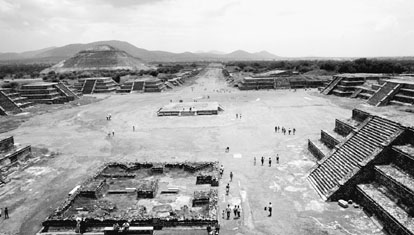

 | Page 1264 |  |
an influx of population from Tlaxcala, which was to the east of Teotihuacán) and coalesced into a large town that rivaled San Cuicuilco in size by 100 b.c.

The main complex at Teotihuacán
(Corel)
The growing rivalry between San Cuicuilco and Teotihuacán was resolved by natural forces. Around the time of Christ, two volcanic eruptions destroyed San Cuicuilco, and the second eruption buried much of the city under several feet of lava. This destruction left Teotihuacán unchallenged in the basin of Mexico, and during the first century a.d., the city grew rapidly. By a.d. 150, the city had a population of about 80,000 people, and probably over 90 percent of the basin’s population lived within twenty kilometers of the city at that time. Some of the reason for this rapid growth was probably a result of the volcanic activity in the southern part of the basin, but it is likely that it was largely the result of a forced relocation of almost all the basin’s population into the growing metropolis.
By a.d. 300 Teotihuacán had reached its maximum population of between 125,000 and 200,000 people, and the city must have been a source of wonder to all who gazed upon it. It was by far the largest city in mesoamerica at the time and one of the largest in the world. The site covered over twenty square kilometers and included two of the largest temple pyramids ever built in Mesoamerica as well as over 100 smaller ones.
The city was laid out in a strict grid oriented 15°25' east of north. Teotihuacán’s central north-south axis (called the Avenue of the Dead by the aztecs) ran for five kilometers, and most of the city’s greatest buildings were alongside it. The massive Pyramid of the Sun, 220 meters to a side and 70 meters high, dominated Teotihuacán. At the northern end of the Avenue of the Dead was the Pyramid of the Moon, and in the center of the city, the huge Citadel faced across the Avenue of the Dead toward the Great Compound. The Citadel was probably where the royalty of Teotihuacán lived, and it is thought that the Great Compound was the marketplace. Inside the Citadel compound was the Pyramid of Quetzalcoatl, with elaborate facade decorations that included images of the Mesoamerican feathered serpent god called Quetzalcoatl by the Aztecs. Flanking this pyramid were two huge palace compounds.
Other elite “palaces” can still be found all along the Avenue of the Dead. The general population was housed in apartment buildings, over 2,000 of which have been mapped (although only a handful have been excavated). These apartment compounds, after about a.d. 200,
 |  |